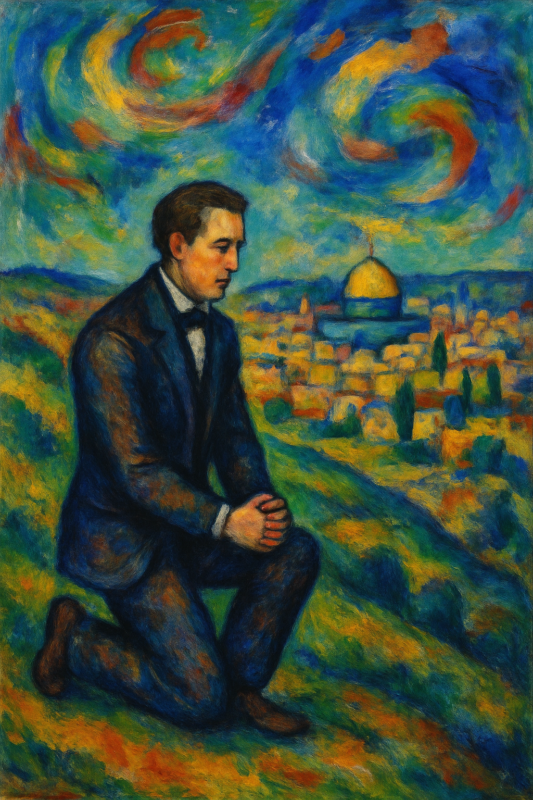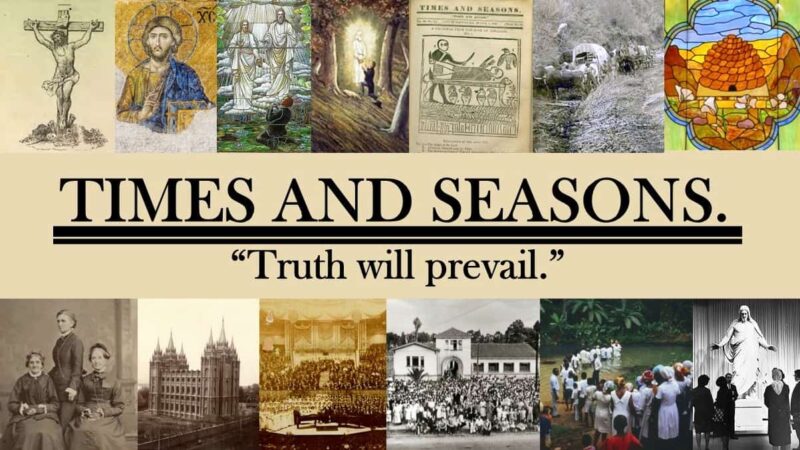
Orson Hyde dedicating the Holy Land for the return of the Jews in the style of Jewish artist Chagall
While the confidence intervals are large, a relatively recent Pew survey suggests that Latter-day Saints are the most pro-Jewish religious group besides Jews themselves, and an older Gallup survey shows that Latter-day Saints are the most pro-Israel religious group besides Jews.
(Yes yes, I know that being pro-Israel does not equal being pro-Jewish necessarily, but still, in this case I think the two are at least related.)
Our philo-semitism does not surprise me. Our own religious aesthetic has Hebrew overtones; when you’re standing by an altar in your temple robes in the temple it’s easy to see yourself as a Levitical priest. We love Fiddler on the Roof and Chaim Potok novels (perhaps in part because it speaks to our own struggles balancing tradition with modernity), and we have a sort of sacred envy for the Jewish religious-intellectual tradition. When I was at BYU taking Biblical Hebrew was what the cool sophisticated gospel scholars did, perhaps even more than taking ancient Greek.
Of course there is a long pedigree of this philo-semitism going back to the early Church.
- In The Evening and Morning Star the Jewish people are a common topic of discussion by WW Phelps. In the 3rd issue Phelps (I believe it’s Phelps) actually disclaims attempted mass conversion of the Jews, a holy grail of Christianity since the Middle Ages, echoing the D&C 45 eschatology where the Jews aren’t converted until Christ splits the Mount of Olives in two.
- In the seventh issue Phelps develops the two gathering places theology implied in D&C 133, where Latter-day Saints are called to gather to Zion while Jews are called to gather to Jerusalem.
- In the 9th issue The Evening and Morning Star carried a call for donations for Jewish community in the Holy Land. Interestingly, its main sponsor was a Christian society working for the conversion of the Jews. The quixotic political alliance between Jews and evangelical Christians wanting to convert the Jews but for whom the Jewish nation plays a role in their eschatology is much older than I thought.
- In Kirtland Joseph Smith spent scarce resources to hire a Jewish teacher of Hebrew.
- D&C 68 and 107 in a sense recognizes the current validity of the Jewish priesthood. (I am surprised there isn’t more 3 Nephites-type Mormon folklore about the hidden high priest who is the rightful heir to Aaron and doesn’t know it.)
- And then finally, to top it all off Orson Hyde dedicated the Holy Land for the return of the Jews.
So our history of Zionism runs deep, and our theology on the matter is a bit more on-the-nose than it is for other Christian groups, and it’s not surprising that we are supportive as we are of Israel. (On the flip side, however, the same survey showed that we are the most anti-Palestinian religious group, something that I’m sure chagrined my Palestinian BYU Middle Eastern politics professor Amr Al-Azm.)
Admittedly this Latter-day Saint brand of philo-semitism can lead to some cultural appropriation and patronizing cringiness (maybe my Chagall portrait of Orson Hyde fits into that category). For example, the popular Mormon custom of doing an alternative seder, and then there’s that common belief that the rebuilt, pre-millennium Temple Mount temple will be an LDS one. And yes, if you are really motivated you can find examples of Church leaders, materials, or members saying classic anti-semitic things, but on the whole I don’t get the sense that classic antisemitism is nearly as much of an issue in the church as, say, anti-immigrant or racist attitudes. There isn’t a lot of folklore, innuendo, or uncouth remarks over the pulpit about financial cabals (it might strike a little close to home–LOL JK).
In part, I suspect some of this is because the Mountain West Latter-day Saint cultural hearth is about as far away as possible from the Jewish American cultural hearths (to be clear, I’m not saying that this is because interactions will confirm stereotypes), so the Jewish community is an abstraction for many members. Utah Latter-day Saints know about Jews because of their religious importance, but they just don’t loom large in day-to-day experiences in the Mountain West; asking a 16-year-old in Utah what they think about Jews is like asking them what they think about Azerbaijanis. As a Utah high schooler I could tell you about all the Pacific Islander or Hispanic stereotypes, but I was a little fuzzy on what the Jewish stereotypes even were (and even now it was only in the past five years or so that I found out about the “Jewish mother” trope). So in a sense Latter-day Saint takes on Judaism can be a patronizing abstraction, but on the other hand we do have relative warm feelings towards them (and their country, although that’s a whole other can of worms).

Comments
10 responses to “Latter-day Saints Love Jews”
Speaking of Mormon Seders and Mormons loving Jews, my wife invited a Jewish woman to our annual Seder this year. We live in a Muslim area, and my wife found out that this woman was feeling bad about not having anyone to have the traditional Seder with. So, with much trepidation, my wife invited her with a full disclosure that she would see cultural appropriation in the extremes.
This Jewish lady seemed to genuinely enjoy the experience and remarked that we had done everything right, with the exception of one or two small details. However, she did say that she found my wife’s fascination with Judaism and her ability to read and speak Hebrew a bit… strange.
What you have written tracks pretty closely with my experience. I would note, however, that our feelings for Jews are generally not reciprocated. Baptizing holocaust victims by proxy and stuff.
More importantly, I think this is a good occasion to remind people that Howard W. Hunter, despite having a very short stint as President of the Church, did leave a legacy that is still honored in practice by the institutional Church, if not by its membership. The following is excerpted from a 1979 Ensign article available here:
From GK Chesterton’s remarks on Mormons:
“these people crossed a great desert with their guns and oxen, patiently, persistently, and courageously, as if they were following a vast and visible giant who was striding across the plains. In other words this strange sect, by soaking itself solely in the Hebrew Scriptures, had really managed to reproduce the atmosphere of those Scriptures as they are felt by Hebrews rather than by Christians. A number of dull, earnest, ignorant, black-coated men with chimney-pot hats, chin beards or mutton-chop whiskers, managed to reproduce in their own souls the richness and the peril of an ancient Oriental experience.”
One other thing. When Hugh Pinnock was president of the Harrisburg Mission in the mid-70s, he was authorized to target Jews in his proselyting efforts. (I understood at the time, and continue to understand, that such authorization was specific to that mission and to that time period only.) I had a high school friend who was called to that mission and was excited to participate in the program. Later, when I lived in Philadelphia, I home taught a Jewish couple who had joined the Church as a result of that effort. They had fond memories of Elder Pinnock (whose son was a member of our ward at the time). Now, all references to that effort seem to have been scrubbed from the internet. I can understand why, given my earlier observation that Jews tend not to return the “love” they receive from Mormons. But it is history and it should be remembered. I hope somebody has kept a record that can be brought forth at a later time.
When I was bishop, we had a guy in the ward with a Jewish wife and our ward council proposed doing a ward seder. She very graciously came with a friend and helped us perform it.
When the idea was suggested in the council, I said, “Uh, are they going to feeling like we’re appropriating their religion?” And a member said, “Oh, it’s only a small percentage of people who get worked up about that. I’m sure it will be fine.” It was.
I see that I forgot to include the link to the Hunter article.
https://www.churchofjesuschrist.org/study/ensign/1979/06/all-are-alike-unto-god?lang=eng
Not many faiths have a warning against antisemitism in their scriptures. Not to mention us having invited ourselves into The Tribe, or least The House, via our patriarchal blessings.
I think (hope?) peak cringiness was Senator Orrin Hatch writing a song for Hanukkah. I just think of it as revenge for some of the Christmas songs I hate that were written by Jews. :)
Dr. Cocoa and Stephen Fleming:
On the issues of Seders, I’m open to there being an appropriate way to do one, but I’d have to think through the specifics (e.g. not breaking the third wall about how they have a chair for Elijah, but we know Elijah already came to the Kirtland Temple).
Last Lemming: That’ s a beautiful quote I wasn’t aware of, thanks! It’s easy to get so wrapped up in the Judah connection we forget about their neighbors.
IAW: I actually had no idea that Chesterton ever said anything about us (or knew about our existence beyond Sherlock Holmes), so that’s kind of fun, even if he managed to flatter and insult us at the same time.
Last Lemming: That’s a really interesting historical factoid. I understand the hesitancy obviously given the history, but I’ve sometimes wondered if we’re weird enough Christans that our proselytizing doesn’t trigger the same reaction that it would coming from a more mainstream Christian faith that is more genetically and theologically related to Martin Luther, the Cossacks, or other not so great figures in Christian-Jewish relations (but maybe not).
RLD: Lol, it would take a lot to beat the cringe of “Rudolph the Red Nosed Reindeer.”
I’ve always found the LDS view of the Jewish people mildly condescending. There’s this feeling when it comes up in church meetings that we view them as children or pets or other lesser creatures, in need of our protecting and assisting, rather than as equals.
Certainly we don’t like them enough to teach their history in a way that is true to them and their religion. Most of the lessons (especially when concerning the Pentateuch) are twisted to support our own (non-Jewish) history and LDS beliefs. That’s always felt deeply disrespectful to me.
We need to love Palestinians also.